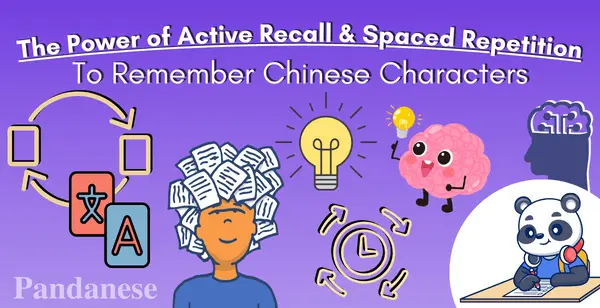
The Power of Active Recall & Spaced Repetition To Remember Chinese Characters
Need to remember Chinese characters quickly?
We have the ultimate tip and a proven method to enhance memory retention to optimize your Mandarin journey.
Get ready to revolutionize your learning approach and unlock the path to language mastery.
Understanding the Spaced Repetition Learning System
What is spaced repetition?

Basic infographic of spaced repetition
Spaced repetition is a learning technique that combines reviewing and revisiting information at specific timed intervals. As you learn and review an item, depending on how easy or difficult it is to recall the information, you would schedule easier information less frequently and more difficult information sooner.
The goal of spaced repetition is to optimize your timing of reviewing materials. Spaced repetition involves spacing out your reviews so that you review the information just before you are likely to forget it. This technique is based on the spacing effect, suggesting that information is better retained when reviewed at spaced intervals rather than in rapid succession.
How to use the spaced repetition algorithm with physical flashcards | Matt BoyleWhat is active recall?
Active recall is a learning technique that combines retrieving information from your memory rather than passively reviewing it. So indeed, by re-reading or re-listening to material, you actively generate the information from your memory without any external cues through flashcards or practice questions.
This process of actively retrieving information strengthens memory and enhances long-term retention.
Recalling information engages your brain deeply and reinforces neural connections related to that information, making it easier to remember in the future.
4 active recall techniques to try | Tiny MedicineWhat is the Spaced Repetition Learning System?
The Spaced Repetition Learning System, also known as Spaced Repetition System (SRS), combines spaced repetition and active recall techniques. The spaced repetition algorithm ensures efficient review intervals, while active recall strengthens memory retention. Together, it encourages consistent practice, reinforces learning, and optimizes memory retention.
Combining these two techniques, the SRS optimizes the timing of reviews based on your performance and actively engages your memory during the recall process. It creates a dynamic and personalized approach for reviewing characters when they are most likely forgotten, leading to efficient and effective learning and long-term retention of Chinese characters.
How can active recall and spaced repetition enhance memory retention?
Combining active recall with spaced repetition reinforces your memory through repeated retrieval and strategic review, making it a powerful technique for learning Chinese characters efficiently. This approach maximizes learning efficiency and helps learners remember characters more effectively and for an extended period.
A. Efficient memorization of Chinese characters
Instead of memorizing Chinese characters all at once, the spaced repetition system focuses on the characters you find more challenging during the learning process. This targeted approach allows you to concentrate on the characters that need more reinforcement, making your study sessions more efficient.
On the other hand, traditional or modern Chinese characters that you find easier to remember will be reviewed less often so that you can have more time to review and practice the more difficult ones.
B. Improved long-term retention
By following the SRS schedule, the Hanzi characters you practiced become deeply ingrained in your memory, making them easily retrievable even after extended periods of non-use.
This long-term retention is particularly beneficial when learning a foreign language, as it ensures you can effortlessly recall characters and maintain proficiency over time.
C. Reduced the forgetting curve:

Projected Forgetting Curve | faq
Practicing characters can often result in forgetting their reading and meaning after some time—known as the "forgetting curve."
To combat this curve, it is crucial to review characters at precise intervals; spaced repetition helps flatten the curve to maximize retention.
D. Personalized learning experience
The Spaced Repetition System adapts to your learning—meaning that, especially if you use software, your learning experience will only work for you and no one else.
So characters that are easier to recall will be scheduled to review less frequently, and more challenging characters will be reviewed more frequently.
With software, you won't have to track, which will need to be reviewed more often. The software will keep track of everything for you so you can focus on remembering the characters.
What are the common mistakes in SRS?
Like all learning methods and techniques, the SRS has common pitfalls that can hinder its effectiveness if not addressed properly.
Let's see these common mistakes and explore how to avoid them to efficiently and successfully retain the Chinese language.
A. Overwhelming yourself with too many characters
Reviewing too many flashcards at once can lead to being overwhelmed and reduce the effectiveness of the Spaced Repetition System, requiring too much effort to manage and diminishing the benefits of spaced repetition. To avoid this, it's important to strike a balance between the number of characters you learn and review, ensuring you have ample time to learn new characters while also reinforcing the ones you have already mastered. This approach allows for more efficient and effective Chinese character retention.
Tip: Focus on quality over quantity to maximize your Chinese character retention and learning progress.
B. Inconsistent study habits
The SRS relies on regular and consistent studying to be effective. So a common mistake is having irregular study sessions where users would intensively study for a few days and take longer breaks before reviewing.
These inconsistent study habits will disrupt the spaced repetition schedule and hinder the reinforcement of memory disrupt the spaced repetition schedule and hinder the reinforcement of memory.
Setting aside 5-20 minutes for learning and reviewing is much easier. Consistency is key to reinforcing memory and ensuring that the spaced repetition intervals are optimized for effective learning.
Tip: Use a reminder app or scheduling tools to help you stay on track with your SRS practice to make it a daily habit.
C. Ignoring Chinese speaking and listening practice
While remembering and recalling Chinese characters is important to read Mandarin, it is also important to incorporate speaking and listening practices to be fully proficient in Chinese.
By actively listening and speaking Chinese with the Hanzi you’ve learned, it will reinforce your understanding of characters in real-life contexts—improving your ability to use them fluently in everyday situations.
Tip: Incorporate Chinese speaking and listening practice into your daily language routine to enhance your language proficiency.
4 tools to remember Chinese Characters
Online platforms to remember Chinese characters
1. Pandanese:

Pandanese is a powerful Hanzi memorization online platform to help learners master Chinese characters by combining SRS and mnemonics.
Starting from the basics, you will learn radicals and Chinese characters first. This method allows you to build up Chinese words and vocabulary easier. The SRS will automatically set reviews for you to actively recall the meaning and reading, while the mnemonic provides a story aid to help you learn those aspects.
With access to an extensive set of characters and vocabulary, Pandanese offers a comprehensive and personalized learning experience, making it an excellent tool for anyone looking to learn Chinese characters quickly and effectively.
Apps with spaced repetition to remember Chinese characters
2. Anki

Anki is a flashcard program that uses the spaced repetition system for creating and using any flashcard deck.
This program is known for its customizability. Anki is perfect for creating a deck for yourself from characters, example sentences, audio, and images.
There are also plenty of pre-made community decks to use. Users can access decks created by others, saving time on creating flashcards from scratch. Though, each deck will vary in its content.
Not too keen about Anki? We have an Anki alternative comparison: The Best Anki Alternative for Chinese Learners, for you to check out.
3. Memrise

Memrise chinese lesson | Memrise
Most well-known as a multimedia language learning app. It uses the SRS to optimize the timing for when characters and vocabulary need to be reviewed, reinforcing active recall with interactive quizzes and exercises.
Memrise is similar to Duolingo, where it will have Hanzi for you to memorize, native pronunciation videos, and example sentences for context, and it will gamify your learning experience with points, levels, and streaks.
Skritter:

Skritter interface | Skritter
This popular app is best known for you to practice your Chinese writing and stroke order.
You get a lot with their basic account. When you open the app, you can choose between simplified or traditional characters, basic Chinese numbers, Chinese stroke order, Chinese colors, and radicals.
The process to help you remember Chinese characters is as follows:
It shows you a character
Give you the definition, meaning, pronunciation
It shows you the stroke order
It helps you trace it
And repeat for the other characters
Frequently asked questions
How do you use active recall and spaced repetition together?
Combining active recall and SRS is a great way to enhance your memory retention in language learning. You can start with flashcards and implement a spaced repetition schedule when reviewing. Cards that are easier to recall will appear less frequently, while challenging ones will appear more often.
What is spaced repetition and active recall language learning?
It is a memory technique that includes learning new words. After a time interval, you would review those words. Ones that are easier to recall and you get correct will be reviewed less frequently, while more difficult ones will be reviewed more often.
What is the best way to memorize Chinese characters?
Combining active recall and spaced repetition is the best way to memorize Chinese characters. Active recall involves retrieving information from memory, such as through flashcards or practice questions. Spaced repetition, on the other hand, optimizes the timing of reviewing characters based on your performance and ensures you review them at intervals that enhance memory retention. This powerful combination reinforces your memory and maximizes your ability to retain and recall Chinese characters effectively.
Need more tips? We have an article to help you memorize Chinese characters: How to Memorize Chinese Characters: A Student-to-Student Guide.
What is spaced repetition for Chinese?
Spaced repetition, also known as Spaced Repetition System (SRS) for Chinese, is a study method that uses spaced intervals to review Chinese characters. The SRS will strategically have you review more difficult words more frequently than those that are easier for you.
In closing
Combining active recall and spaced repetition is a powerful method for learning how to remember Chinese characters. The active recall will retrieve information from your memory, with the SRS will help you review specific characters that need to be worked on.
Embracing this technique and avoiding common mistakes will revolutionize your Chinese language journey.
The easiest way to learn Chinese & build vocabulary

